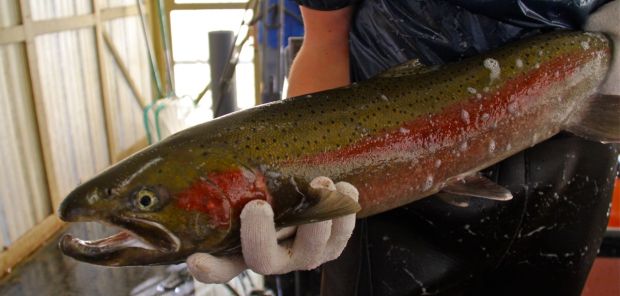forum
library
tutorial
contact

Salmon Hatchery Findings Should
Inform a Top-to-Bottom Review
by Editorial Board
The Oregonian, March 10, 2016
|
the film forum library tutorial contact |

|
Salmon Hatchery Findings Should
by Editorial Board
|
The region deserves a report card showing clear metrics for success and for failure in one of its most expensive endeavors.
 Fitting out the Columbia Basin with hydroelectric dams transformed the Pacific Northwest. Abundant, clean and cheap electricity would drive business growth and settlement, while an elaborate system of river locks allowed barges to connect the ocean with ports far inland. What was once a wild and rocky waterway teeming with salmon became a series of slackwater lakes yoked in service to development and the economies of Oregon, Washington, Idaho and Montana.
Fitting out the Columbia Basin with hydroelectric dams transformed the Pacific Northwest. Abundant, clean and cheap electricity would drive business growth and settlement, while an elaborate system of river locks allowed barges to connect the ocean with ports far inland. What was once a wild and rocky waterway teeming with salmon became a series of slackwater lakes yoked in service to development and the economies of Oregon, Washington, Idaho and Montana.
But even the best things can bring corollary damage. The Northwest's iconic salmon would plunge into decline. Taming the once-wild Columbia River hammered celebrated salmon runs of more than 16 million wild fish to just a few million annually. In abundance, instead, have been salmon hatcheries -- hundreds lining the river and its tributaries and pouring millions upon millions of baby factory fish into the river to offset the decline in wild stocks. It is not unreasonable to say hatcheries have allowed Northwest citizens to honor longstanding commitments to upriver tribes, which have treaty rights to a guaranteed level of harvestable fish, and to support recreational and once-thriving commercial fisheries. Nothing's perfect. Besides, the federal government correctly insisted, under the Endangered Species Act, that the Northwest's wild salmon be saved from extinction.
The dollar cost, however, has been staggering. More than $15 billion has been spent since 1978 in attempting to recover Columbia Basin salmon in what has to be the largest wildlife stewardship ever in North America. A study of Columbia Basin salmon-recovery efforts performed by economists more than a decade ago pegged the public's investment in hatchery fall chinook at a low of $64.35 per surviving fish, while the price soared to $7,437.50 for every adult sockeye that managed to navigate dams and outswim predators to return to a hatchery in Boise.
But are the wild fish on the rebound? Most salmon caught in the Columbia Basin are from hatcheries. So the persistent question all along has been: Do hatchery fish help to rebuild federally protected runs of salmon? Or are they meat factories whose progeny weaken wild stocks through interbreeding and otherwise alter the basin-by-basin forces that made wild stocks evolutionarily fit and distinct from one another? More simply put, is the world's most ambitious wildlife recovery plan doomed? And: At what cost? And again: What is the price, under ESA, of failure?
Significantly, scientists at Oregon State University recently declared that a hatchery fish is not a wild fish. The hatchery-versus-wild question has been debated for years, despite the fact that hatchery managers do their best to create fish from wild stocks. But the OSU team found that hatchery fish quickly adapt to hatchery conditions, becoming anything but wild. After just one generation of domestication, the DNA of hatchery steelhead trout was found to be substantially different from the DNA of steelhead whose parents were wild, Kelly House of The Oregonian/OregonLive reported. Hatchery-bashing anecdotes of dumbed-down fish, Frankenfish and other behavioral traits have been reduced, critically, to a matter of genetics.
Gov. Kate Brown and Gov. Jay Inslee should report this year on the state of salmon recovery in the Columbia Basin. The implications are huge: for wild, protected fish and for Northwesterners subsidizing their recovery in a tamed Columbia River.
Hatcheries have evolved tremendously since their start several decades ago. But now, with the recognition that a fish's genes are quickly changed by the environment of a hatchery, hatchery managers know they must create fish that are more and more like wild fish if they are to serve the goal of rebuilding native wild stocks.
This is less about fish, ultimately, than a hugely expensive public policy. Salmon recovery spending dwarfs in scale so many legislative commitments, not to mention capital improvement programs at the municipal level.
Oregon Gov. Kate Brown and Washington Gov. Jay Inslee should jointly report this year on the state of salmon recovery in the Columbia Basin. The region deserves a report card showing clear metrics for success and for failure in one of its most expensive endeavors. To do so would be to go beyond the steady noise from court challenges, and judges' decrees, that hardly suffice as debate about fish recovery.
Meanwhile, researchers for the federal NOAA Fisheries, which oversees salmon recovery efforts, must double down to determine whether the region is on-course for success or failure in hatchery programs, and share with the governors a timetable for doing so. Staff from the Portland-headquartered Northwest Power and Conservation Council, comprising governor appointees from the four Northwest states and guiding the federal Bonneville Power Administration in its wildlife spending, should do likewise -- in consultation with NOAA. And pertinent wildlife agencies in Oregon neighboring states, along with Northwest tribes that historically have lauded hatchery efforts, must weigh in.
The salmon-saving effort is just too expensive to get wrong.
Related Pages:
Cantwell Pushes NOAA to Reduce Delays in Approving Hatchery Genetic Management Plans by Staff, The Columbian, 2/26/16
Study Looks at Cost Effectiveness of Habitat Restoration Compared to Hatcheries by Staff, Columbia Basin Bulletin, 4/3/15
Wild Fish Advocates Threaten Suit Over Hatcheries by Rich Landers, Walla Walla Union-Bulletin, 1/20/16
learn more on topics covered in the film
see the video
read the script
learn the songs
discussion forum
